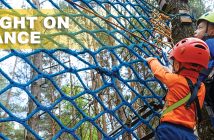The long-term sustainability and success of an adventure park is rooted in diligent risk management processes and activities. Let this overview of risk management provide a guideline for addressing some of the most significant challenges posed by the inherent and real risks to clients and staff who climb about in trees, grapple with ropes course elements, and ride zip lines.
The work of risk management takes place in two arenas: pre-loss and post-loss. Pre-loss work relates to those goals, objectives, and activities that are planned and implemented prior to a loss occurring. They are designed, in fact, to prevent losses, and/or mitigate the losses that could occur. Post-loss goals, objectives, and activities are implemented following a loss. It often helps to think about risk management strategies and tactics by placing them in one time frame or the other.
PRE-LOSS CONSIDERATIONS
It is beyond the scope of this article to address all of the aspects of pre-loss risk management planning. You should develop a comprehensive risk management plan in conjunction with your insurance company, legal representative, course manager, professional trainer, and original equipment manufacturer (OEM) or qualified vendor. The following list of categories provides a road map by which you can begin to develop a more comprehensive plan:
• communications that serve to inform and warn
• visitor/participant training and education
• releases and waivers
• inspections of equipment and premises
• personal protective equipment (PPE) selection and use
• operational plans, policies, guidelines, and procedures
• documentation of all of the above
Communications
Operators of activities with inherent risks must provide information and warnings to guests—prior to paying and participating. This information should include the potential hazards associated with the activity, and requirements of participants with respect to strength, agility, decision-making, health, etc. It should also outline restrictions on participation, including age, weight, height, and medical conditions.
Regardless of the content, to effectively communicate to the guest, you must implement an integrated system of communications. This system might include a combination of signs, printed and electronic collateral materials, posters, and scripting for employees (to cover all information and safety topics). These should be delivered at multiple touch points, so that there are redundant opportunities for guests to hear, see, comprehend, ask questions, share concerns, and apply the information. You can even attempt to communicate with your guests prior to arrival at your park. By delivering information through more than one method and in multiple media, you can accommodate different learning styles and provide repetition, which is a key to retention.
In implementing such a system, take care to accurately represent your services, products, and credentials, as well as the risks involved. Avoid making claims that over-promise or misrepresent the reality of the business and activity, such as “our course meets or exceeds all industry standards” and “safety is our number one priority.”
Such statements are difficult to prove in court and easily manipulated by a plaintiff’s attorney.






